Abstract
A total of 360 patients underwent preoperative cardiac risk assessment using 23 clinical parameters, seven multivariate clinical scoring systems, and quantitative dipyridamole-thallium imaging to predict postoperative and long-term myocardial infarction and cardiac death after noncardiac surgery. There were 30 postoperative and an additional 13 cumulative long-term cardiac events after an average follow-up of 15 months. Clinical descriptors were not useful in predicting the outcome of individual patients. The postoperative and long-term cardiac event rates were 1% and 3.5%, respectively, in patients with normal scans or fixed perfusion defects, and 17.5% and 22% in patients with reversible defects. Using quantitative indices reflecting the amount of jeopardized myocardium, patients could be stratified by dipyridamole imaging into multiple scintigraphic subsets, with corresponding postoperative and 1-year coronary morbidity and mortality rates ranging from 0.5% to 100% (p = 0.0001). Thus, postoperative and long-term cardiac events cannot be predicted clinically, whereas quantitative dipyridamole imaging accurately identifies high-risk patients who require preoperative coronary angiography.
Full text
PDF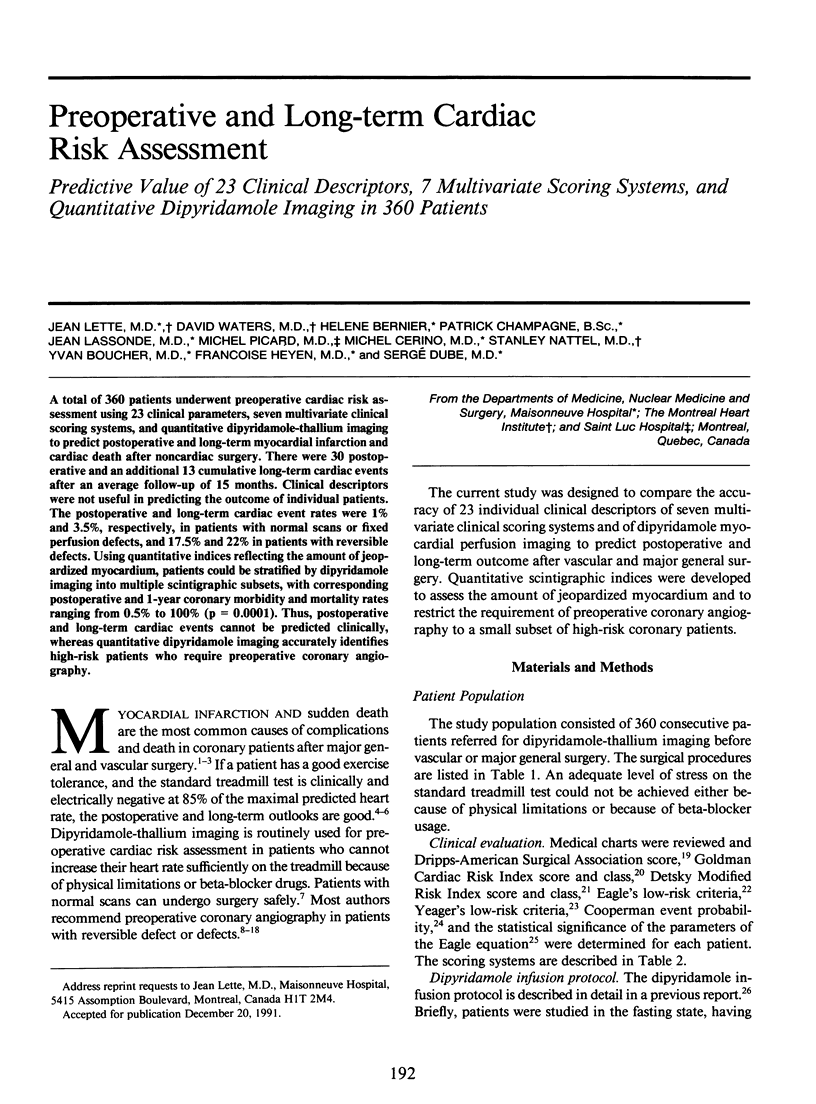
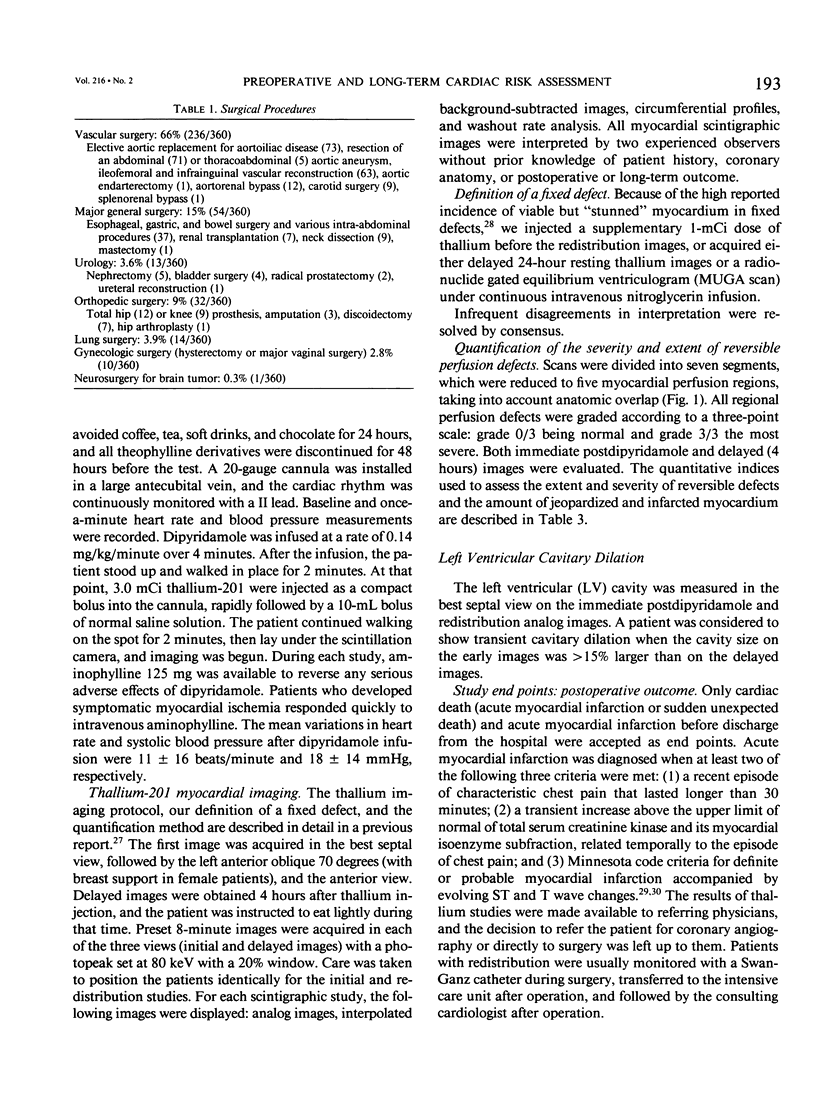
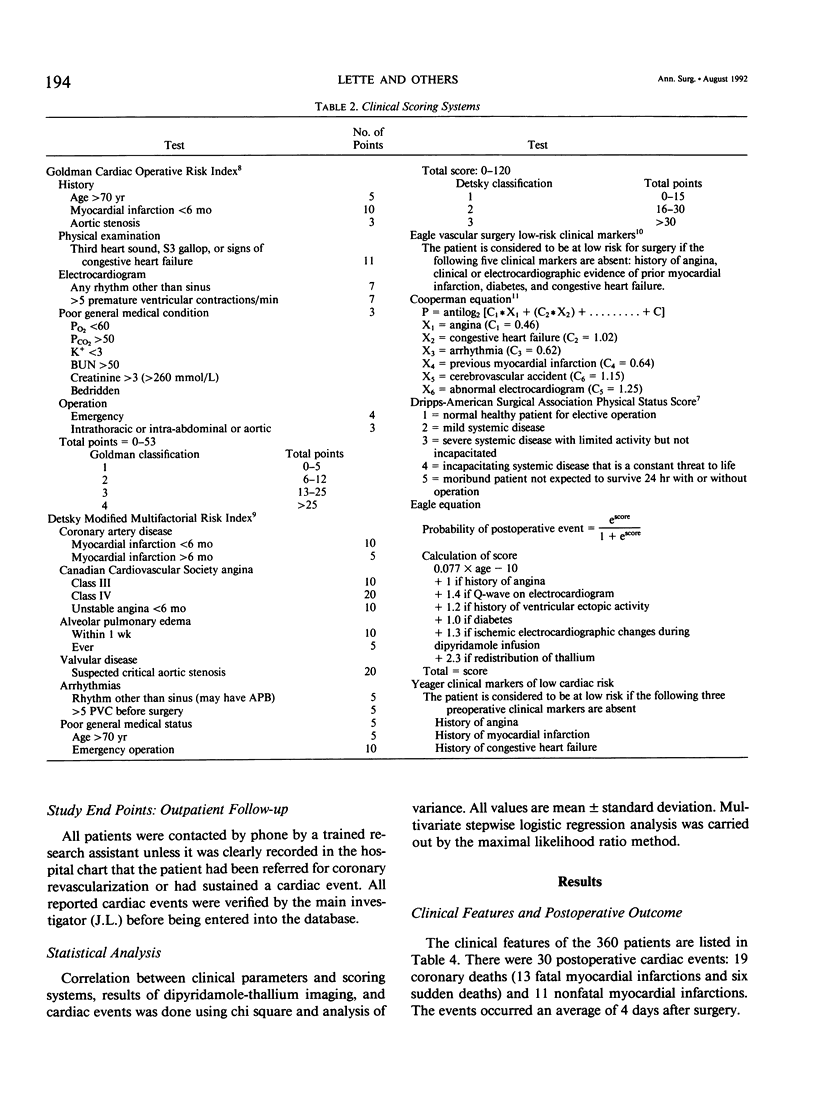
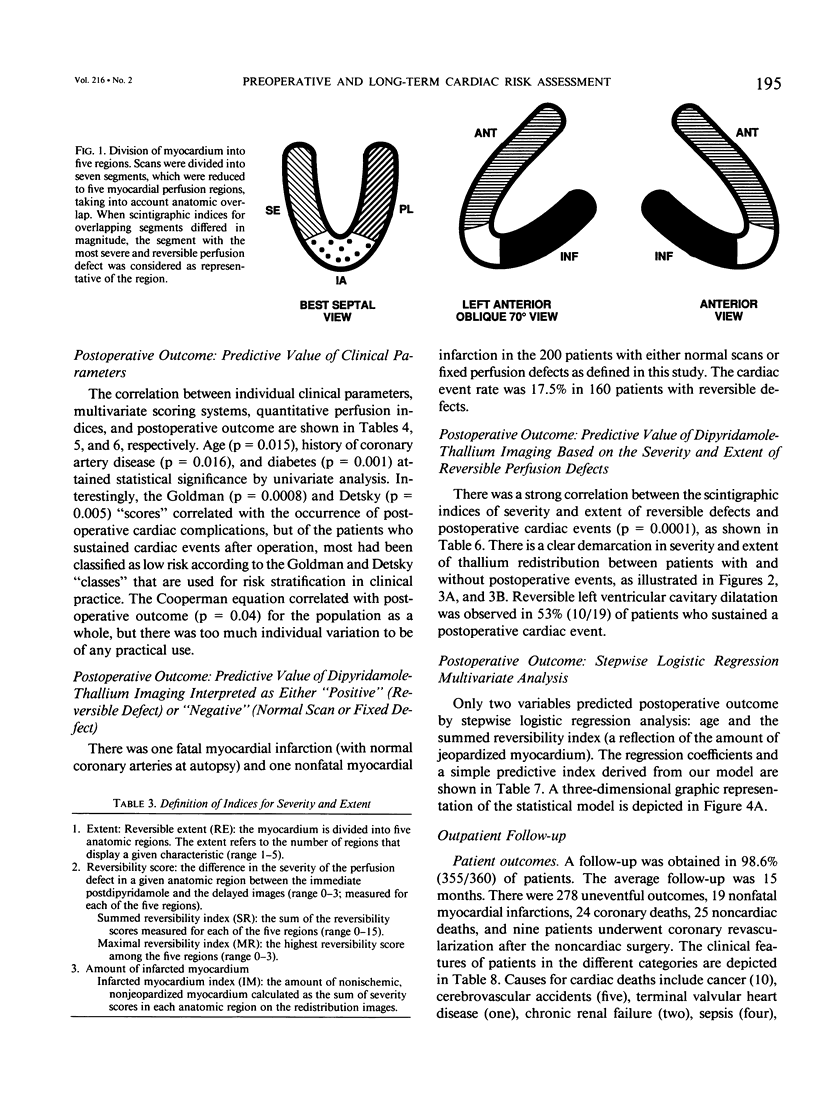
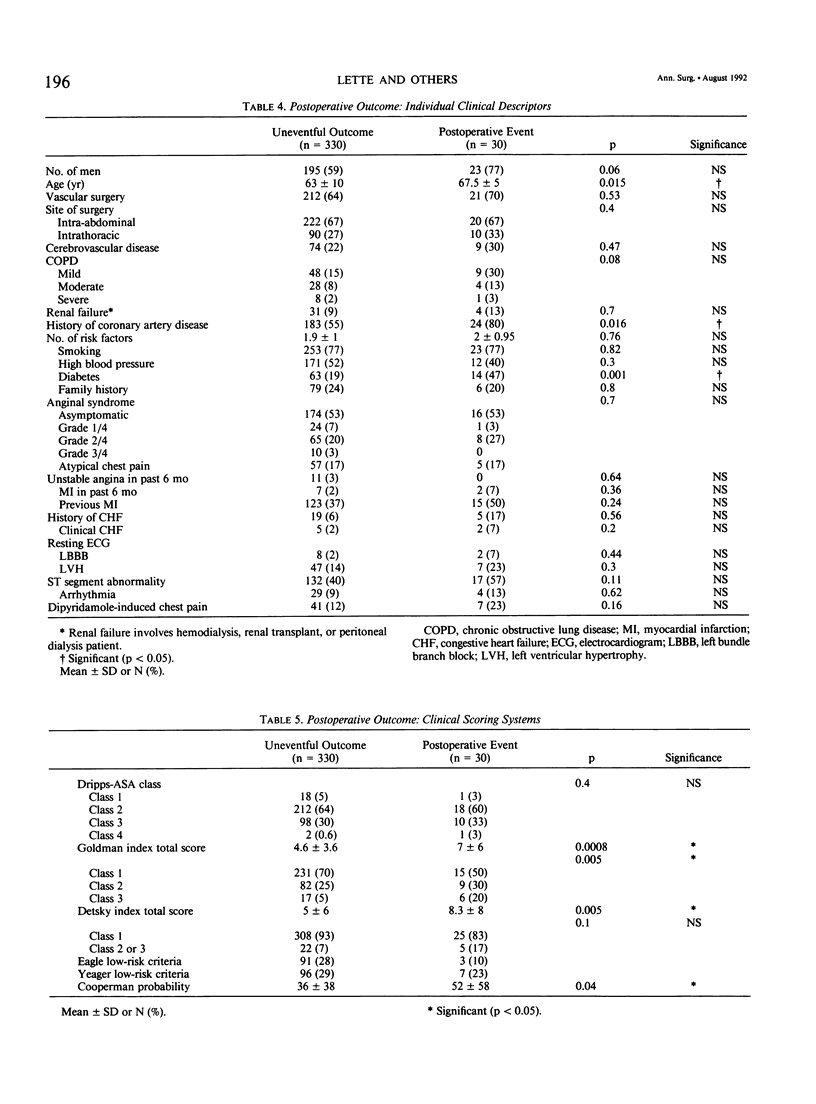
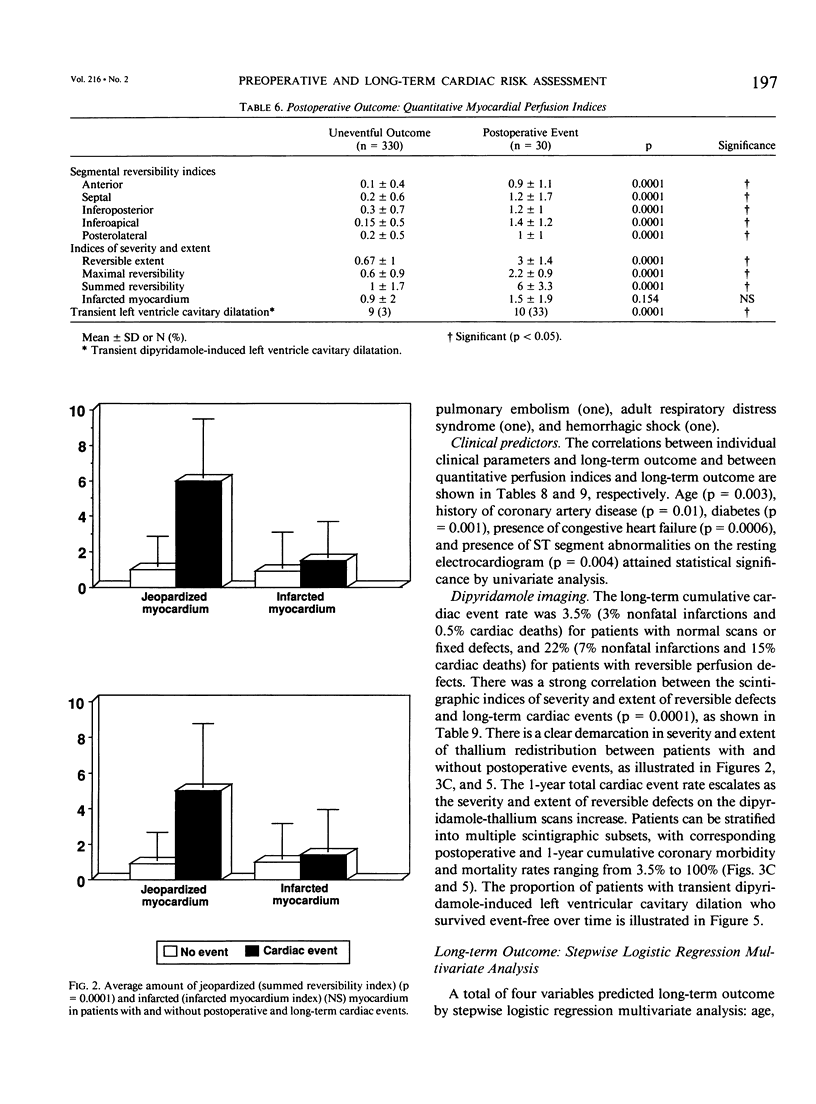
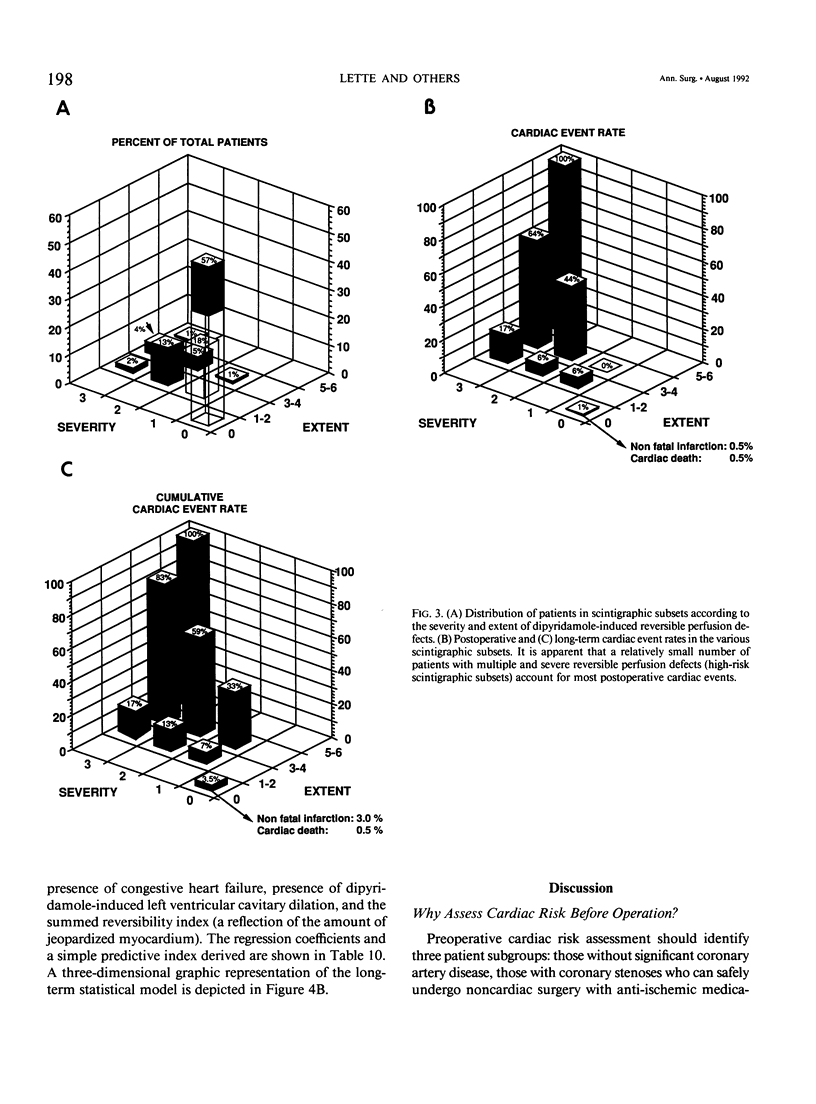
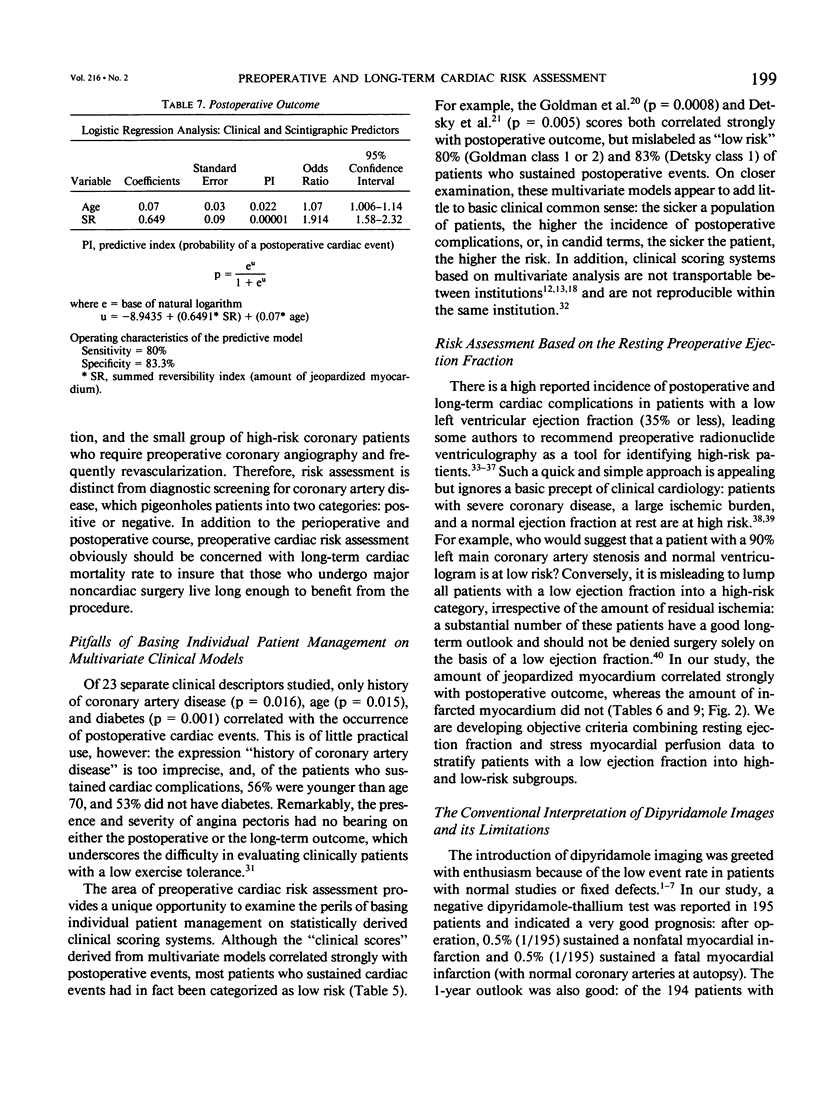
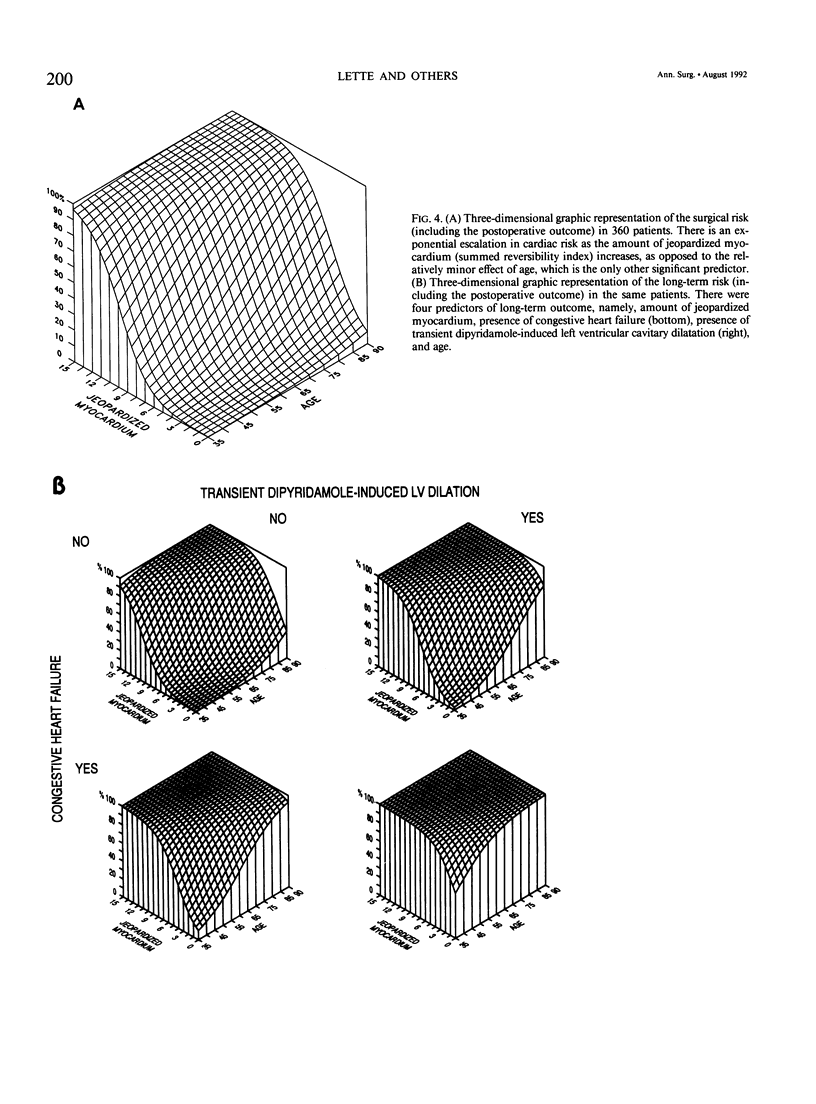
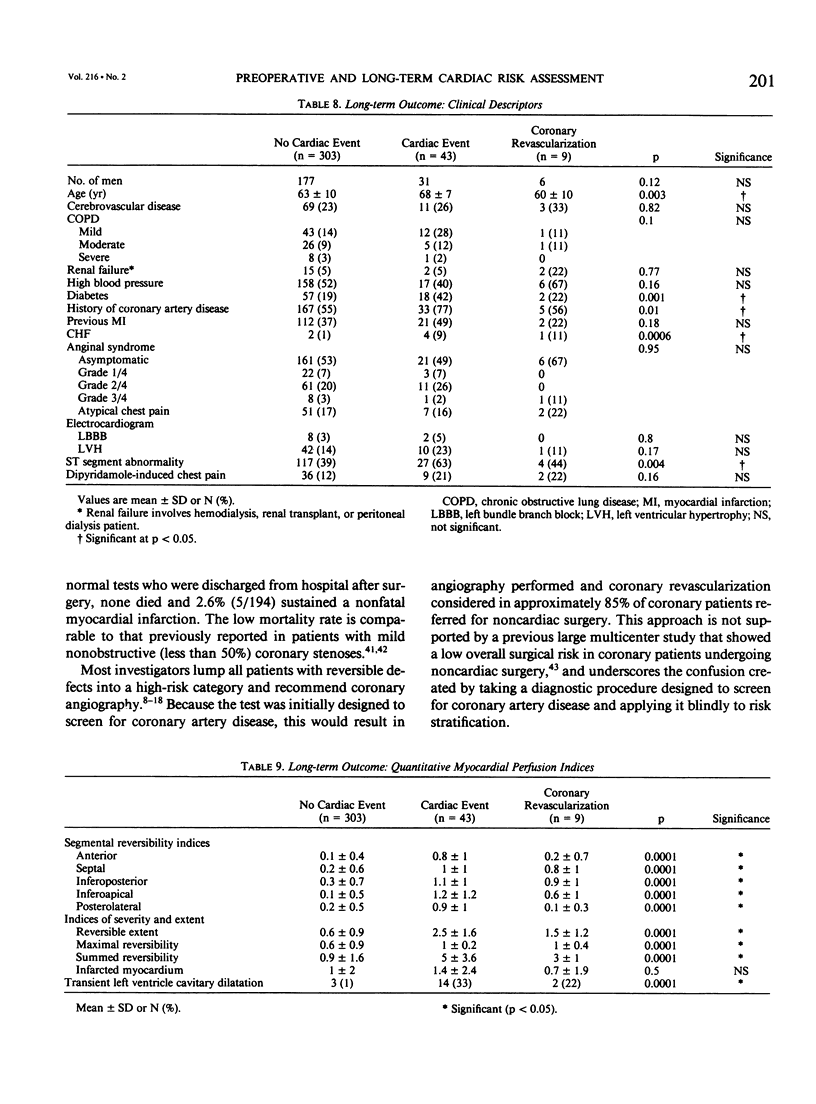
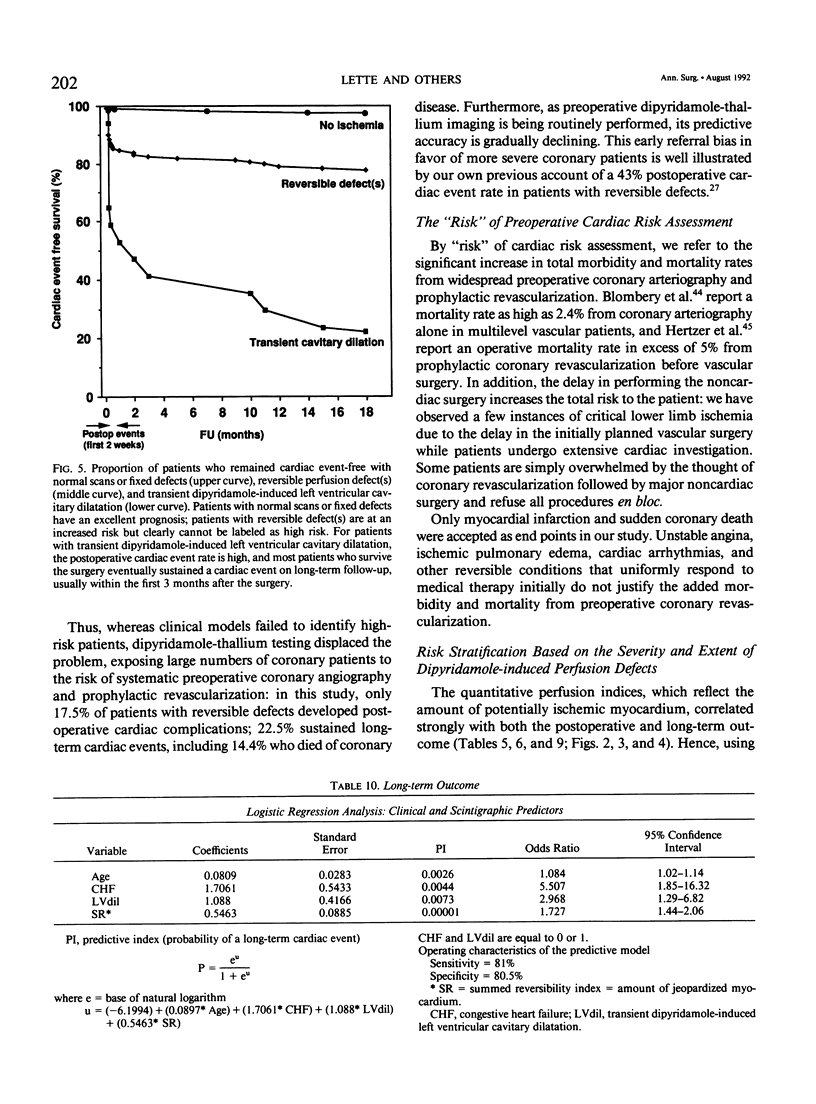

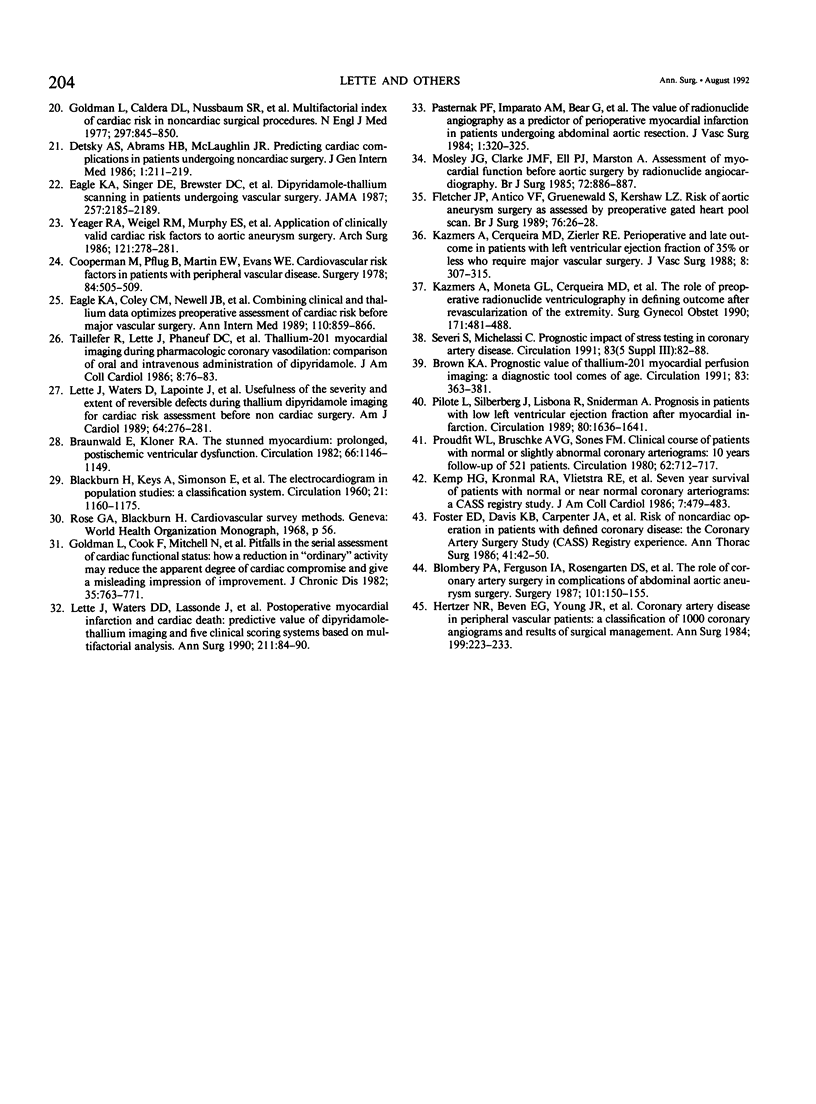
Selected References
These references are in PubMed. This may not be the complete list of references from this article.
- Arous E. J., Baum P. L., Cutler B. S. The ischemic exercise test in patients with peripheral vascular disease. Implications for management. Arch Surg. 1984 Jul;119(7):780–783. doi: 10.1001/archsurg.1984.01390190024005. [DOI] [PubMed] [Google Scholar]
- BLACKBURN H., KEYS A., SIMONSON E., RAUTAHARJU P., PUNSAR S. The electrocardiogram in population studies. A classification system. Circulation. 1960 Jun;21:1160–1175. doi: 10.1161/01.cir.21.6.1160. [DOI] [PubMed] [Google Scholar]
- Blombery P. A., Ferguson I. A., Rosengarten D. S., Stuchbery K. E., Miles C. R., Black A. J., Pitt A., Anderson S. T., Harper R. W., Federman J. The role of coronary artery disease in complications of abdominal aortic aneurysm surgery. Surgery. 1987 Feb;101(2):150–155. [PubMed] [Google Scholar]
- Boucher C. A., Brewster D. C., Darling R. C., Okada R. D., Strauss H. W., Pohost G. M. Determination of cardiac risk by dipyridamole-thallium imaging before peripheral vascular surgery. N Engl J Med. 1985 Feb 14;312(7):389–394. doi: 10.1056/NEJM198502143120701. [DOI] [PubMed] [Google Scholar]
- Braunwald E., Kloner R. A. The stunned myocardium: prolonged, postischemic ventricular dysfunction. Circulation. 1982 Dec;66(6):1146–1149. doi: 10.1161/01.cir.66.6.1146. [DOI] [PubMed] [Google Scholar]
- Brewster D. C., Okada R. D., Strauss H. W., Abbott W. M., Darling R. C., Boucher C. A. Selection of patients for preoperative coronary angiography: use of dipyridamole-stress--thallium myocardial imaging. J Vasc Surg. 1985 May;2(3):504–510. doi: 10.1067/mva.1985.avs0020504. [DOI] [PubMed] [Google Scholar]
- Brown K. A. Prognostic value of thallium-201 myocardial perfusion imaging. A diagnostic tool comes of age. Circulation. 1991 Feb;83(2):363–381. doi: 10.1161/01.cir.83.2.363. [DOI] [PubMed] [Google Scholar]
- Calvin J. E., Kieser T. M., Walley V. M., McPhail N. V., Barber G. G., Scobie T. K. Cardiac mortality and morbidity after vascular surgery. Can J Surg. 1986 Mar;29(2):93–97. [PubMed] [Google Scholar]
- Camp A. D., Garvin P. J., Hoff J., Marsh J., Byers S. L., Chaitman B. R. Prognostic value of intravenous dipyridamole thallium imaging in patients with diabetes mellitus considered for renal transplantation. Am J Cardiol. 1990 Jun 15;65(22):1459–1463. doi: 10.1016/0002-9149(90)91355-a. [DOI] [PubMed] [Google Scholar]
- Cooperman M., Pflug B., Martin E. W., Jr, Evans W. E. Cardiovascular risk factors in patients with peripheral vascular disease. Surgery. 1978 Oct;84(4):505–509. [PubMed] [Google Scholar]
- Cutler B. S., Leppo J. A. Dipyridamole thallium 201 scintigraphy to detect coronary artery disease before abdominal aortic surgery. J Vasc Surg. 1987 Jan;5(1):91–100. doi: 10.1067/mva.1987.avs0050091. [DOI] [PubMed] [Google Scholar]
- DRIPPS R. D., LAMONT A., ECKENHOFF J. E. The role of anesthesia in surgical mortality. JAMA. 1961 Oct 21;178:261–266. doi: 10.1001/jama.1961.03040420001001. [DOI] [PubMed] [Google Scholar]
- Deron S. J., Kotler M. N. Noncardiac surgery in the cardiac patient. Am Heart J. 1988 Sep;116(3):831–838. doi: 10.1016/0002-8703(88)90345-6. [DOI] [PubMed] [Google Scholar]
- Detsky A. S., Abrams H. B., McLaughlin J. R., Drucker D. J., Sasson Z., Johnston N., Scott J. G., Forbath N., Hilliard J. R. Predicting cardiac complications in patients undergoing non-cardiac surgery. J Gen Intern Med. 1986 Jul-Aug;1(4):211–219. doi: 10.1007/BF02596184. [DOI] [PubMed] [Google Scholar]
- Eagle K. A., Coley C. M., Newell J. B., Brewster D. C., Darling R. C., Strauss H. W., Guiney T. E., Boucher C. A. Combining clinical and thallium data optimizes preoperative assessment of cardiac risk before major vascular surgery. Ann Intern Med. 1989 Jun 1;110(11):859–866. doi: 10.7326/0003-4819-110-11-859. [DOI] [PubMed] [Google Scholar]
- Eagle K. A., Singer D. E., Brewster D. C., Darling R. C., Mulley A. G., Boucher C. A. Dipyridamole-thallium scanning in patients undergoing vascular surgery. Optimizing preoperative evaluation of cardiac risk. JAMA. 1987 Apr 24;257(16):2185–2189. [PubMed] [Google Scholar]
- Eagle K. A., Singer D. E., Brewster D. C., Darling R. C., Mulley A. G., Boucher C. A. Dipyridamole-thallium scanning in patients undergoing vascular surgery. Optimizing preoperative evaluation of cardiac risk. JAMA. 1987 Apr 24;257(16):2185–2189. [PubMed] [Google Scholar]
- Fletcher J. P., Antico V. F., Gruenewald S., Kershaw L. Z. Dipyridamole-thallium scan for screening of coronary artery disease prior to vascular surgery. J Cardiovasc Surg (Torino) 1988 Nov-Dec;29(6):666–669. [PubMed] [Google Scholar]
- Fletcher J. P., Antico V. F., Gruenewald S., Kershaw L. Z. Risk of aortic aneurysm surgery as assessed by preoperative gated heart pool scan. Br J Surg. 1989 Jan;76(1):26–28. doi: 10.1002/bjs.1800760109. [DOI] [PubMed] [Google Scholar]
- Foster E. D., Davis K. B., Carpenter J. A., Abele S., Fray D. Risk of noncardiac operation in patients with defined coronary disease: The Coronary Artery Surgery Study (CASS) registry experience. Ann Thorac Surg. 1986 Jan;41(1):42–50. doi: 10.1016/s0003-4975(10)64494-3. [DOI] [PubMed] [Google Scholar]
- Gage A. A., Bhayana J. N., Balu V., Hook N. Assessment of cardiac risk in surgical patients. Arch Surg. 1977 Dec;112(12):1488–1492. doi: 10.1001/archsurg.1977.01370120078009. [DOI] [PubMed] [Google Scholar]
- Gillet T., Lecorff G., Scemama J., Bernard P. J., Mercier C., Serradimigni A. Approche diagnostique de la coronaropathie en chirurgie vasculaire. Place de la scintigraphie myocardique. J Mal Vasc. 1990;15(1):55–62. [PubMed] [Google Scholar]
- Goldman L., Caldera D. L., Nussbaum S. R., Southwick F. S., Krogstad D., Murray B., Burke D. S., O'Malley T. A., Goroll A. H., Caplan C. H. Multifactorial index of cardiac risk in noncardiac surgical procedures. N Engl J Med. 1977 Oct 20;297(16):845–850. doi: 10.1056/NEJM197710202971601. [DOI] [PubMed] [Google Scholar]
- Goldman L., Cook E. F., Mitchell N., Flatley M., Sherman H., Cohn P. F. Pitfalls in the serial assessment of cardiac functional status. How a reduction in "ordinary" activity may reduce the apparent degree of cardiac compromise and give a misleading impression of improvement. J Chronic Dis. 1982;35(10):763–771. doi: 10.1016/0021-9681(82)90087-x. [DOI] [PubMed] [Google Scholar]
- Hertzer N. R., Beven E. G., Young J. R., O'Hara P. J., Ruschhaupt W. F., 3rd, Graor R. A., Dewolfe V. G., Maljovec L. C. Coronary artery disease in peripheral vascular patients. A classification of 1000 coronary angiograms and results of surgical management. Ann Surg. 1984 Feb;199(2):223–233. doi: 10.1097/00000658-198402000-00016. [DOI] [PMC free article] [PubMed] [Google Scholar]
- Hertzer N. R. Fatal myocardial infarction following peripheral vascular operations. A study of 951 patients followed 6 to 11 years postoperatively. Cleve Clin Q. 1982 Spring;49(1):1–11. doi: 10.3949/ccjm.49.1.1. [DOI] [PubMed] [Google Scholar]
- Iskandrian A. S., Heo J., Askenase A., Segal B. L., Auerbach N. Dipyridamole cardiac imaging. Am Heart J. 1988 Feb;115(2):432–443. doi: 10.1016/0002-8703(88)90492-9. [DOI] [PubMed] [Google Scholar]
- Kazmers A., Cerqueira M. D., Zierler R. E. Perioperative and late outcome in patients with left ventricular ejection fraction of 35% or less who require major vascular surgery. J Vasc Surg. 1988 Sep;8(3):307–315. [PubMed] [Google Scholar]
- Kazmers A., Moneta G. L., Cerqueira M. D., Healy D. A., Zierler R. E., Harley J. D. The role of preoperative radionuclide ventriculography in defining outcome after revascularization of the extremity. Surg Gynecol Obstet. 1990 Dec;171(6):481–488. [PubMed] [Google Scholar]
- Kemp H. G., Kronmal R. A., Vlietstra R. E., Frye R. L. Seven year survival of patients with normal or near normal coronary arteriograms: a CASS registry study. J Am Coll Cardiol. 1986 Mar;7(3):479–483. doi: 10.1016/s0735-1097(86)80456-9. [DOI] [PubMed] [Google Scholar]
- Leppo J., Boucher C. A., Okada R. D., Newell J. B., Strauss H. W., Pohost G. M. Serial thallium-201 myocardial imaging after dipyridamole infusion: diagnostic utility in detecting coronary stenoses and relationship to regional wall motion. Circulation. 1982 Sep;66(3):649–657. doi: 10.1161/01.cir.66.3.649. [DOI] [PubMed] [Google Scholar]
- Lette J., Waters D., Lapointe J., Gagnon A., Picard M., Cerino M., Kerouac M. Usefulness of the severity and extent of reversible perfusion defects during thallium-dipyridamole imaging for cardiac risk assessment before noncardiac surgery. Am J Cardiol. 1989 Aug 1;64(5):276–281. doi: 10.1016/0002-9149(89)90519-5. [DOI] [PubMed] [Google Scholar]
- Lette J., Waters D., Lassonde J., Dubé S., Heyen F., Picard M., Morin M. Postoperative myocardial infarction and cardiac death. Predictive value of dipyridamole-thallium imaging and five clinical scoring systems based on multifactorial analysis. Ann Surg. 1990 Jan;211(1):84–90. doi: 10.1097/00000658-199001000-00015. [DOI] [PMC free article] [PubMed] [Google Scholar]
- McCabe C. J., Reidy N. C., Abbott W. M., Fulchino D. M., Brewster D. C. The value of electrocardiogram monitoring during treadmill testing for peripheral vascular disease. Surgery. 1981 Feb;89(2):183–186. [PubMed] [Google Scholar]
- Mosley J. G., Clarke J. M., Ell P. J., Marston A. Assessment of myocardial function before aortic surgery by radionuclide angiocardiography. Br J Surg. 1985 Nov;72(11):886–887. doi: 10.1002/bjs.1800721113. [DOI] [PubMed] [Google Scholar]
- Pasternack P. F., Imparato A. M., Bear G., Riles T. S., Baumann F. G., Benjamin D., Sanger J., Kramer E., Wood R. P. The value of radionuclide angiography as a predictor of perioperative myocardial infarction in patients undergoing abdominal aortic aneurysm resection. J Vasc Surg. 1984 Mar;1(2):320–325. doi: 10.1067/mva.1984.avs0010320. [DOI] [PubMed] [Google Scholar]
- Pilote L., Silberberg J., Lisbona R., Sniderman A. Prognosis in patients with low left ventricular ejection fraction after myocardial infarction. Importance of exercise capacity. Circulation. 1989 Dec;80(6):1636–1641. doi: 10.1161/01.cir.80.6.1636. [DOI] [PubMed] [Google Scholar]
- Proudfit W. L., Bruschke V. G., Sones F. M., Jr Clinical course of patients with normal or slightly or moderately abnormal coronary arteriograms: 10-year follow-up of 521 patients. Circulation. 1980 Oct;62(4):712–717. doi: 10.1161/01.cir.62.4.712. [DOI] [PubMed] [Google Scholar]
- Sachs R. N., Tellier P., Larmignat P., Azorin J., Fischbein L., Beaudet B., Cadilhac P., Cupa M., De Saint Florent G., Vulpillat M. Assessment by dipyridamole-thallium-201 myocardial scintigraphy of coronary risk before peripheral vascular surgery. Surgery. 1988 May;103(5):584–587. [PubMed] [Google Scholar]
- Taillefer R., Lette J., Phaneuf D. C., Léveillé J., Lemire F., Essiambre R. Thallium-201 myocardial imaging during pharmacologic coronary vasodilation: comparison of oral and intravenous administration of dipyridamole. J Am Coll Cardiol. 1986 Jul;8(1):76–83. doi: 10.1016/s0735-1097(86)80094-8. [DOI] [PubMed] [Google Scholar]
- Yeager R. A., Weigel R. M., Murphy E. S., McConnell D. B., Sasaki T. M., Vetto R. M. Application of clinically valid cardiac risk factors to aortic aneurysm surgery. Arch Surg. 1986 Mar;121(3):278–281. doi: 10.1001/archsurg.1986.01400030032004. [DOI] [PubMed] [Google Scholar]
- Younis L. T., Aguirre F., Byers S., Dowell S., Barth G., Walker H., Carrachi B., Peterson G., Chaitman B. R. Perioperative and long-term prognostic value of intravenous dipyridamole thallium scintigraphy in patients with peripheral vascular disease. Am Heart J. 1990 Jun;119(6):1287–1292. doi: 10.1016/s0002-8703(05)80177-2. [DOI] [PubMed] [Google Scholar]


